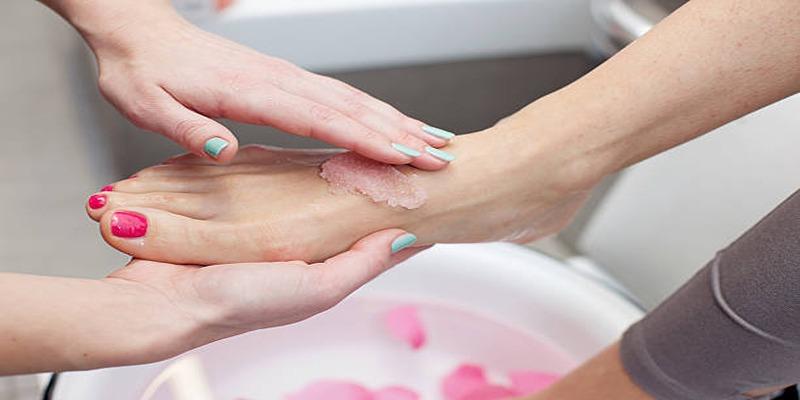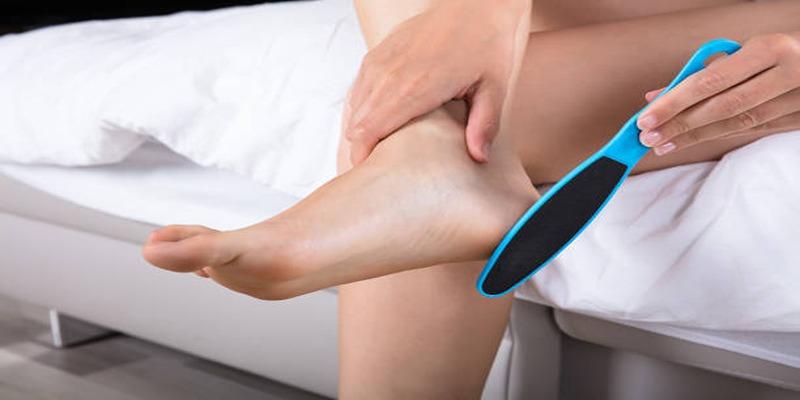9 Effective Methods to Exfoliate and Refresh Your Feet
Jul 11, 2024 By Nancy Miller
Maintaining soft and smooth feet isn't just about aesthetics; it's also vital for overall foot health. Our feet endure significant stress daily, leading to the accumulation of dead skin, calluses, and rough patches. Exfoliation is a crucial part of a foot care routine, helping to remove these layers of dead skin and revealing the fresh, healthy skin beneath. In this guide, we will explore nine effective methods to exfoliate and refresh your feet, ensuring they remain in top condition. From natural remedies to specialized tools, these techniques are designed to suit a variety of needs and preferences, making it easier than ever to pamper your feet and keep them soft and smooth.
1.Pumice Stone
A pumice stone is one of the most traditional and effective tools for exfoliating your feet. Formed from volcanic rock, this lightweight and porous stone is perfect for sloughing off dead skin and smoothing calluses. To use a pumice stone, soak your feet in warm water for about 10 minutes to soften the skin. Gently rub the stone in circular motions on the rough areas, being careful not to press too hard to avoid irritation. Rinse your feet, and follow up with a moisturizing lotion to keep them hydrated. Regular use of a pumice stone can significantly improve the texture of your feet, leaving them soft and rejuvenated.
2.Foot Scrub
A foot scrub combines exfoliating ingredients with soothing agents to effectively remove dead skin and refresh your feet. You can purchase ready-made scrubs or create your own using natural ingredients like sugar, salt, and essential oils. To use a foot scrub, start by soaking your feet in warm water for about 10 minutes. Apply a generous amount of the scrub to your feet, focusing on the heels, balls, and other rough areas. Massage the scrub using circular motions to enhance its exfoliating effect. Rinse your feet thoroughly with warm water and pat them dry. Follow up with a rich moisturizer to lock in hydration. Regular use of a foot scrub can leave your feet feeling smooth, revitalized, and pampered.
3.Exfoliating Socks
Exfoliating socks are a convenient and innovative way to achieve smoother and softer feet. These socks are pre-soaked in a solution containing exfoliating agents such as alpha hydroxy acids (AHAs) and beta hydroxy acids (BHAs), which work to gently peel away layers of dead skin. To use exfoliating socks, start by washing and drying your feet thoroughly. Slip on the socks and leave them on for the suggested duration, typically between 30 minutes to an hour. Once you remove the socks, rinse your feet with warm water. Over the next few days, you will notice the dead skin starting to peel off, revealing fresh and healthy skin beneath. The exfoliation process can continue for up to two weeks, resulting in remarkably smooth feet. This method is especially beneficial for those with busy lifestyles, offering an effortless way to maintain foot health and hygiene.
4.Foot Peel Mask
Foot peel masks offer a thorough exfoliation experience by using a combination of potent ingredients such as glycolic acid, lactic acid, and natural extracts. These masks are typically worn like socks, providing an intense treatment that targets the buildup of dead skin. Application involves washing and drying your feet, then placing them into the mask for the recommended duration, usually about 60-90 minutes. After removal, rinse your feet with warm water. Over the following days, you will observe a gradual peeling of the dead skin layers. This process can last up to two weeks, but the results are remarkably satisfying, with significantly smoother and softer feet. Foot peel masks are ideal for those seeking a low-effort yet highly effective exfoliation method.
5.Foot Brush
Using a foot brush is an excellent method for exfoliating and cleansing your feet. These brushes often come with firm bristles designed to tackle rough skin and improve circulation. To use a foot brush, begin by soaking your feet in warm water to soften the skin. Apply a small amount of foot cleanser or soap to the brush and scrub your feet using firm, circular motions, concentrating on callused or rough areas. This helps to remove dead skin cells and leaves your feet feeling clean and refreshed. Rinse thoroughly and follow up with a moisturizing lotion to maintain hydration. Incorporating a foot brush into your regular foot care routine can lead to smoother, healthier feet over time.
6.Epsom Salt Soak
Epsom salt, composed of magnesium sulfate, offers therapeutic and exfoliating benefits for your feet. To create an Epsom salt soak, dissolve half a cup of Epsom salt in a basin of warm water. Soak your feet for about 15-20 minutes to soften the skin and relieve any aches or pains. The salt's natural exfoliating properties help slough off dead skin cells, while the magnesium can reduce swelling and improve circulation. After soaking, scrub your feet gently with a pumice stone or foot brush to enhance exfoliation. Rinse your feet with clean water, dry thoroughly, and apply a rich moisturizer. This method not only leaves your feet feeling soft and refreshed but also promotes relaxation and overall foot health.
7.Sugar Scrub
A sugar scrub is an excellent way to exfoliate and rejuvenate your feet using simple, natural ingredients. Combining the coarse texture of sugar with moisturizing oils, a sugar scrub effectively removes dead skin cells and leaves your feet feeling soft and smooth. To create your own sugar scrub, mix half a cup of granulated sugar with a quarter cup of coconut oil or olive oil. For added benefits, you can also include a few drops of essential oils like peppermint or lavender. Massage the scrub onto your feet in circular motions, paying special attention to rough areas. Rinse thoroughly with warm water and pat your feet dry. Regular use of a sugar scrub will keep your feet healthy, moisturized, and refreshed.
8.Baking Soda Paste
Baking soda, known for its versatile properties, can be transformed into an effective exfoliating paste for your feet. To make the paste, combine three tablespoons of baking soda with one tablespoon of water to form a thick mixture. Apply this paste to your damp feet, focusing on callused or rough areas. Massage gently in circular motions to exfoliate dead skin cells and smooth out rough patches. Baking soda also has natural antibacterial and antifungal properties, making it a great option for maintaining foot hygiene. After scrubbing, rinse your feet thoroughly with warm water and apply a moisturizer to keep them hydrated. Regular use of a baking soda paste can leave your feet feeling soft, rejuvenated, and refreshed.
9.Foot File
A foot file is an essential tool for maintaining smooth and healthy feet. Typically made from metal or sandpaper-like materials, it efficiently removes hardened, dead skin from the feet. To use a foot file, begin by soaking your feet in warm water to soften the skin for about 10 minutes. Once your feet are softened, gently rub the foot file against rough areas, focusing primarily on your heels and calluses. It's essential to use a gentle hand to avoid irritating the skin. After filing, rinse your feet to wash away the exfoliated skin particles and pat dry. Conclude the process by applying a thick, moisturizing cream to keep your feet hydrated and soft. Regular use of a foot file can help prevent the build-up of hard, dead skin, keeping your feet in top condition.
Conclusion
Incorporating these foot care techniques into your routine can transform your feet from rough and dry to soft and healthy. Whether you choose a simple sugar scrub, a relaxing Epsom salt soak, or a robust foot peel mask, each method offers unique benefits suited to various needs. By consistently practicing these methods, you not only improve the aesthetic appearance of your feet but also enhance their overall health and comfort. Take the time to care for your feet; they support you every day and deserve the best possible maintenance.







